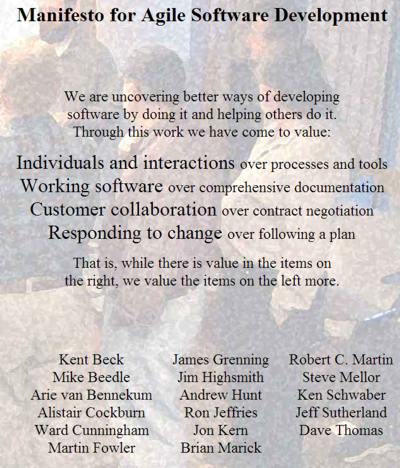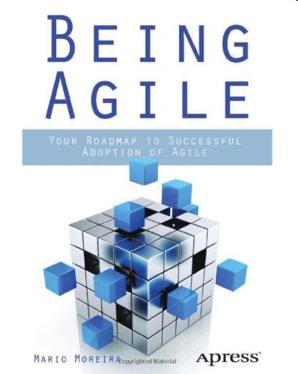| Being Agile |
|
Author: Mario Moreira
The subtitle of this book is "Your Roadmap to Successful Adoption of Agile" and it is aimed at a wide audience.
In Chapter 1 the primary readers are listed as:
The book is intended not only to help readers adopt the practices and methodologies of Agile but to go from “doing Agile” to “being Agile” which Mario Moreira says “requires buy-in across the enterprise.” As well as setting out the purpose of the book and the topics to be covered the first chapter also gives advice about how to navigate the book suggesting which chapters to read according to your needs and prior knowledge. I decided to start at the end of the book and look at the final chapter (24) which presents three case studies in organizations that differed not only in size but also in the degree of initial buy-in on the part of senior management as well as team members to adopting Agile. This is a good place to start as it alerts you to the pitfalls in following the proposed road map to agile.
If you don't know much about Agile, or need to be convinced why you should adopt it, Chapter 2 with the title “Crossing the Agile Chasm” explains that Agile really is a culture change. The next chapter outlines “Business Benefits of Being Agile” concentrating on those that concern money, customers and employees. It introduces the Agile Value to Incentive Differentiation (AVID) framework and follows up with two chapters on the Importance of Customer Engagement and Importance, which introduces continuous customer engagement and minimum viable product (MVP) of Employee Engagement, which discusses employee empowerment, self-organizing teams and value-added work (VAW). If you are new to Agile Chapter 6 Foundations of Agile makes a better starting point. It is here we find a central premise of the book, that Agile is a set of values and principles and that the Agile mindset is essentially a state of being. Here too we are presented with the Agile Manifesto, which in case you don't already have it engraved in you mind is shown here:
Source: agilemanifesto.org, 2001
Moreira points out that the last phrase doesn't mean disregard the items on the right but rather focus more on those on the left. He provides with a deeper look at each of the four pairs of agile values and then outlines the Twelve Principles of Agile Software that the authors of the Manifesto provided as supporting material and these are discussed in depth in Chapter 9. Chapter 6 also provides an introduction to Agile processes and methodologies and explains that Scrum refers to the iterative and incremental framework used to build software; the fact that a Scrum Team should be self-organizing and the roles of the Scrum Master, the Product Owner and the Development Team. It introduces the Scrum events of Sprint Planning, the Daily Scrum, the Sprint Review and the Sprint Retrospective. If you don't already know about sprints there isn't enough detail here, although there is more in Chapter 18 which looks at user stories and the sprint backlog. So, if you want a beginner's introduction to Agile methodology you need another book – and the footnotes provide plenty of suitable references. It also has further reading suggestions for the other frameworks it discusses Extreme Programming (XP), Dynamic Systems Development Method (DSDM), Kanban, Lean Software Development and Value, Flow Quality (VFQ). The end of the chapter reminds you that Moreira holds the view that Agile is not a set of processes, methodologies, practice and tools but is instead a set of values and principles and his book continues to develop the mindset required to adopt them.
The book's author is an Agile Coach and Chapter 7 outlines the framework he uses to help teams adopt Agile. Its acronym is RICH – Ready, Implement, Coach, Hone and he briefly goes through each of these deployment stages which are revisited along with ways to evaluate their success in subsequent chapters. In Chapter 8 Moreira returns to the topic of Motivations for Moving to an Agile Culture and this time looks at adapting rewards and managing resistance and the importance of establishing a shared definition of Agile. He looks at storytelling as a technique for achieving the desired Agile culture. For those intent on deploying Agile methodology Chapter 12 Adapting to Agile Roles and Responsibilities discusses who in a traditional team best suits the core agile roles of Scrum Master and Product Owner. It also looks at the key attributes of an effective Agile Coach. Chapters 18 and 19 go into technicalities of the Product Backlog, Story points and Sprint Burndown, while Chapter 20 goes into the definition of Done and Done-Done and there are forays into Application Lifecycle Management in Chapter 21 and into IT governance and performance review in Chapter 23. By the end of the book I felt that all the target audiences would gain from reading this book. In some ways it moderated my naïve enthusiasm for Agile – as the case histories reveal there is a lot that can go wrong. On the other hand if you take on board its central premise, that Agile is a mindset and requires a fundamental and all-embracing culture change, you will be in a better position to succeed with it.
|
|||
| Last Updated ( Saturday, 12 July 2014 ) |


